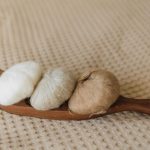You might think polypropylene and polyester fabrics are the same, but they’re quite different. Polypropylene is lighter, moisture-wicking, and great for insulation, while polyester feels softer, handles UV exposure better, and is more elastic. Polypropylene resists chemicals and dries fast, but polyester’s recycling options are stronger. Each suits different needs from sportswear to industrial use. If you want to understand how their unique traits affect your choice, keep exploring these key differences.
Table of Contents
Key Takeaways
- Polypropylene is made from propylene monomers via addition polymerization, while polyester is produced through condensation polymerization of terephthalic acid and ethylene glycol.
- Polypropylene offers superior moisture-wicking and dries faster, making it better for high-sweat conditions compared to polyester.
- Polyester feels softer and smoother on the skin, whereas polypropylene may feel rougher and less flexible.
- Polypropylene resists chemicals and abrasion well, but polyester withstands UV exposure and retains shape better under sunlight.
- Polyester has a more developed recycling infrastructure, while polypropylene requires less energy to produce but both are non-biodegradable synthetic fabrics.
Chemical Composition and Manufacturing Processes
Although both polypropylene and polyester are synthetic fibers, their chemical compositions and manufacturing processes differ considerably.
Polypropylene and polyester are both synthetic fibers but differ significantly in chemistry and production methods.
You’ll find that polypropylene is made from propylene monomers, a type of hydrocarbon derived from petroleum refining. It’s polymerized through a process called addition polymerization, which links the monomers into long chains without forming byproducts.
Polyester, on the other hand, primarily comes from terephthalic acid and ethylene glycol through a condensation polymerization process, producing water as a byproduct.
When it comes to manufacturing, polypropylene fibers are typically extruded through spinnerets and cooled rapidly to form fine filaments. Polyester fibers go through a melt-spinning process, where the polymer melts before being extruded and solidified.
Understanding these differences helps you recognize why each fiber behaves uniquely in various applications.
Moisture Absorption and Breathability
When you’re choosing between polypropylene and polyester, understanding how each handles moisture is key.
You’ll want to evaluate their moisture-wicking abilities and how well they allow airflow for comfort.
Let’s explore how these factors affect your experience wearing each fabric.
Moisture Wicking Properties
Since you rely on your clothing to keep you comfortable during physical activities, understanding moisture wicking properties is essential.
Polypropylene excels here because it doesn’t absorb water; instead, it pulls moisture away from your skin and pushes it to the fabric’s surface, where it evaporates quickly. This keeps you dry and prevents chafing during workouts or outdoor adventures.
Polyester also wicks moisture but tends to absorb slightly more than polypropylene, which can leave you feeling damp over longer periods.
Both fabrics dry faster than natural fibers, but polypropylene’s superior moisture management makes it a preferred choice if you sweat heavily or exercise intensely.
Knowing these differences helps you pick fabric that actively manages moisture, so you stay comfortable and focused no matter the activity.
Airflow and Comfort
Because your comfort depends heavily on how well a fabric allows air to circulate, understanding airflow and breathability is key when choosing between polypropylene and polyester.
Polypropylene excels in moisture absorption and wicks sweat away from your skin, keeping you dry during intense activities. Its low moisture retention means the fabric dries quickly, enhancing comfort.
On the other hand, polyester also offers good breathability but tends to absorb more moisture, which can leave you feeling damp if you sweat heavily. However, polyester fabrics often feature engineered weaves that improve airflow and ventilation.
When deciding, consider your activity level and climate—polypropylene suits high-sweat, warm conditions, while polyester works well for moderate activity and cooler environments where breathability still matters.
Durability and Resistance to Wear
Although both polypropylene and polyester offer strong durability, you’ll find they perform differently under wear and tear.
Polypropylene resists abrasion and chemical exposure better, making it ideal for rough conditions. Polyester, on the other hand, handles UV exposure well, meaning it won’t degrade quickly in sunlight.
When it comes to stretching, polyester maintains shape better, while polypropylene tends to stretch out over time.
Here’s what you should know:
- Polypropylene excels in chemical and moisture resistance.
- Polyester resists UV rays, fading less over time.
- Polyester retains shape and resists stretching.
- Polypropylene withstands abrasion but can lose elasticity.
Choosing between them depends on the specific durability needs of your project or garment.
Comfort and Feel Against the Skin
When you wear polypropylene or polyester, you’ll notice differences in softness and breathability that affect comfort.
Each fabric handles moisture in its own way, which can change how they feel against your skin.
Let’s explore how these factors impact your daily wear experience.
Softness Comparison
If you prioritize comfort, you’ll notice that polyester usually feels smoother against the skin than polypropylene.
Polyester fibers are finer and softer, giving you a silky touch, while polypropylene tends to feel a bit rougher and less flexible.
When comparing these fabrics, consider these key points:
- Texture: Polyester offers a softer, more luxurious feel.
- Flexibility: Polyester bends easily, reducing stiffness.
- Irritation: Polypropylene may cause mild skin irritation for sensitive individuals.
- Durability vs Softness: Polypropylene is tough but less gentle on your skin.
Breathability Differences
How well a fabric breathes can make a big difference in your comfort, especially during physical activity or hot weather.
Polypropylene fabric offers excellent breathability because its fibers allow air to circulate freely, helping you stay cooler. You’ll notice it feels lighter and less stuffy against your skin.
Polyester, on the other hand, tends to be less breathable since its fibers are tighter and trap more heat. This can make you feel warmer and sometimes a bit clammy if you’re moving a lot.
If you prioritize staying cool and comfortable, polypropylene might be the better choice. However, remember that breathability isn’t the only factor affecting how a fabric feels, so consider your specific needs before deciding.
Moisture Management
Although both polypropylene and polyester fabrics handle moisture differently, understanding their moisture management can greatly impact your comfort and how the fabric feels against your skin.
Polypropylene excels at wicking moisture away from your body, keeping you dry and comfortable during intense activities. Polyester also wicks moisture but tends to retain some, which might leave you feeling slightly damp.
Here are key points to evaluate:
- Polypropylene repels water, so sweat doesn’t soak in.
- Polyester absorbs some moisture, which can affect comfort.
- Polypropylene dries faster, ideal for high-sweat situations.
- Polyester’s moisture retention makes it softer but less dry.
Choose based on your activity level and how dry or soft you want your fabric to feel.
Environmental Impact and Sustainability
When choosing between polypropylene and polyester, you should consider their environmental impact and sustainability. Both fabrics are synthetic and derived from petrochemicals, meaning they rely on non-renewable resources.
However, polypropylene typically uses less energy to produce, which slightly lowers its carbon footprint. On the flip side, polyester has a well-established recycling infrastructure, allowing you to find recycled polyester options more easily.
Polypropylene uses less energy to produce, but polyester benefits from a stronger recycling infrastructure.
Neither fabric biodegrades quickly, so they contribute to long-term waste if not recycled. If sustainability matters to you, look for recycled versions of either fabric and support brands committed to reducing environmental harm.
Being mindful of how you care for and dispose of these materials can also reduce microplastic pollution and lessen their overall impact on the planet.
Common Uses and Applications
Both polypropylene and polyester serve a wide range of purposes, making them versatile choices in various industries. When you pick between these fabrics, understanding their common uses helps you choose the right one for your needs.
- Activewear and Sportswear: Polyester’s moisture-wicking ability makes it ideal for workout clothes, while polypropylene is great for thermal wear due to its insulation.
- Home Textiles: You’ll find polyester in curtains and upholstery because of its durability, whereas polypropylene is popular in rugs and outdoor furniture for its resistance to moisture.
- Industrial Applications: Polypropylene is used in ropes, filters, and packaging due to its chemical resistance. Polyester suits conveyor belts and tire reinforcements.
- Medical Textiles: Both fabrics appear in disposable gowns and masks, with polypropylene favored for its lightweight and breathable properties.
Choosing the right fabric depends on your specific application and priorities.
Frequently Asked Questions
Can Polypropylene Fabric Be Recycled as Easily as Polyester?
You’ll find polypropylene harder to recycle than polyester because it’s less commonly accepted by recycling programs. Polyester’s widespread use means you’re more likely to find facilities that handle it efficiently, making recycling simpler for you.
Which Fabric Is Better for Allergy Sufferers?
Like choosing a shield in battle, you’ll find polypropylene better for allergy sufferers since it resists moisture and allergens, while polyester tends to trap dust and irritants. So, you’ll breathe easier with polypropylene.
How Do Polypropylene and Polyester Fabrics Respond to High Heat?
You’ll find polypropylene melts at lower temperatures, so avoid high heat with it. Polyester handles higher heat better but can still shrink or warp if exposed to extreme temperatures. Always check care labels before washing or ironing.
Are There Differences in Dyeing or Color Retention Between the Two Fabrics?
You’ll find polypropylene resists dye well, so colors might fade or appear dull. Polyester holds dye better, offering vibrant, long-lasting colors. So, if color retention matters, you’ll prefer polyester over polypropylene fabric.
What Are the Cost Differences Between Polypropylene and Polyester Fabrics?
You might think fabric costs are a secret government conspiracy, but polypropylene’s usually cheaper than polyester. So, if you’re on a budget, you’ll appreciate polypropylene saving your wallet while still keeping your clothes functional.
- Recycling Nonwoven Fabrics: Is It Possible? - July 11, 2025
- Recycling Nonwoven Fabrics: Is It Possible? - July 11, 2025
- Recycling Nonwoven Fabrics: Is It Possible? - July 11, 2025







